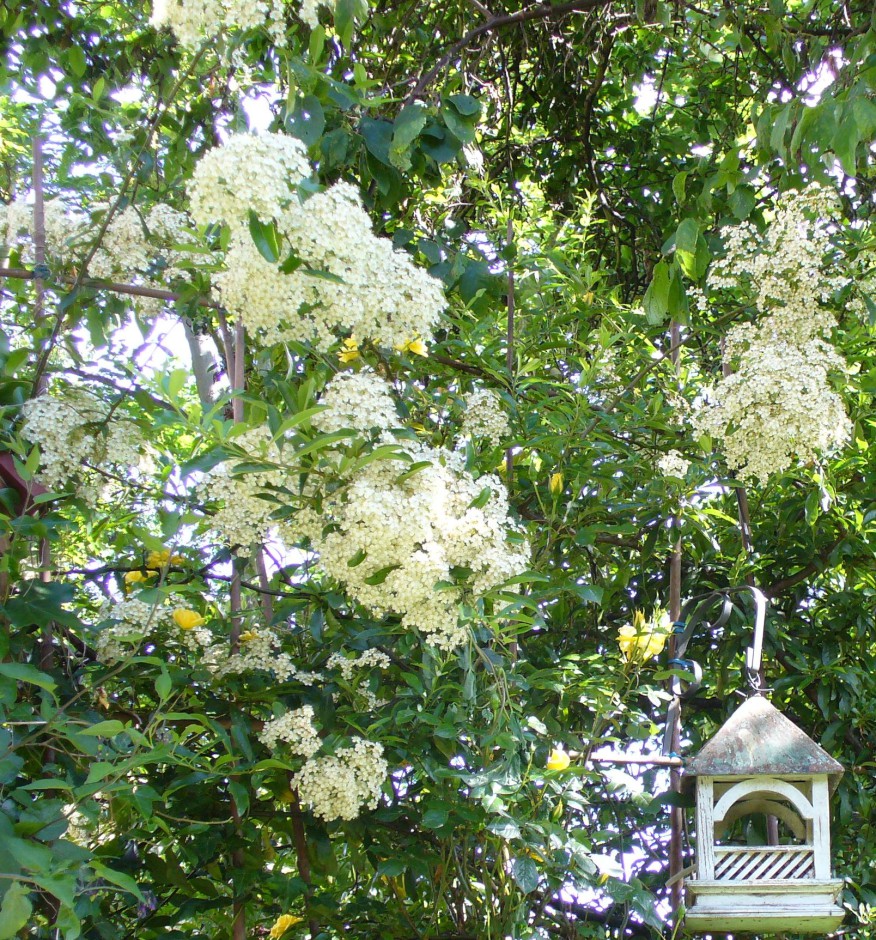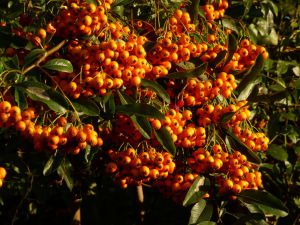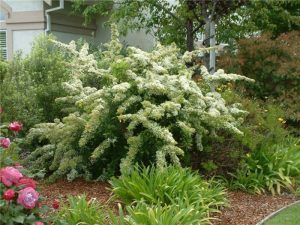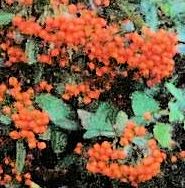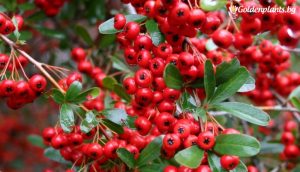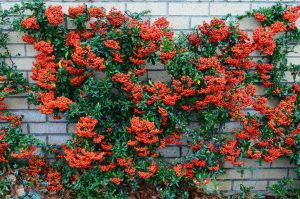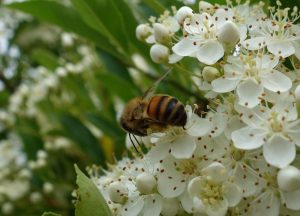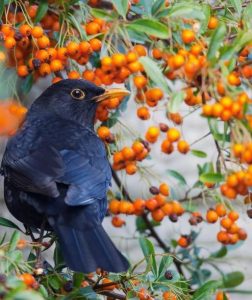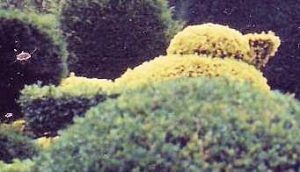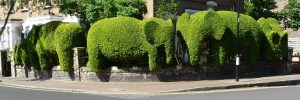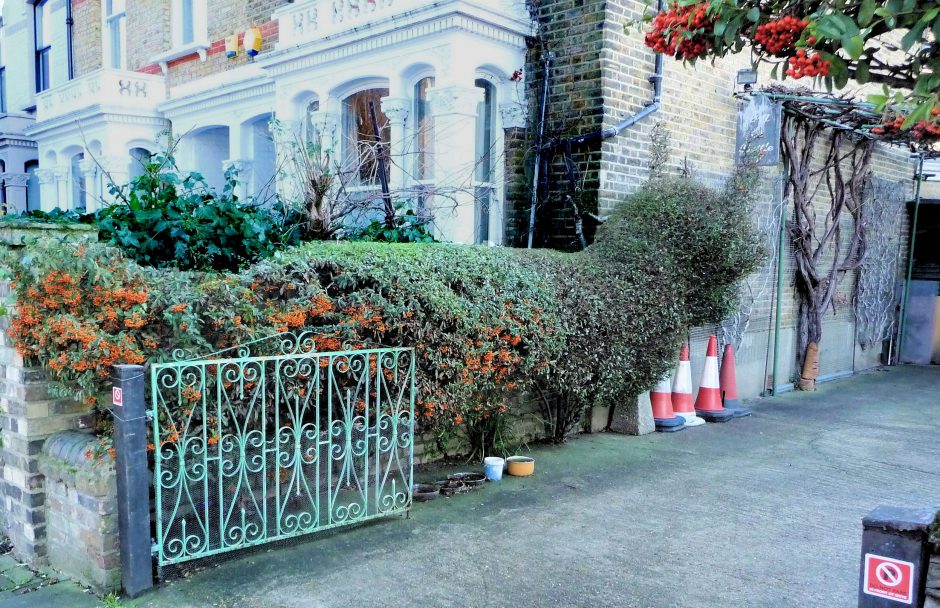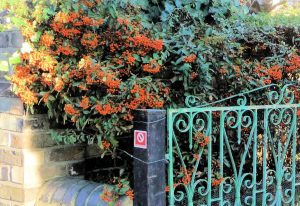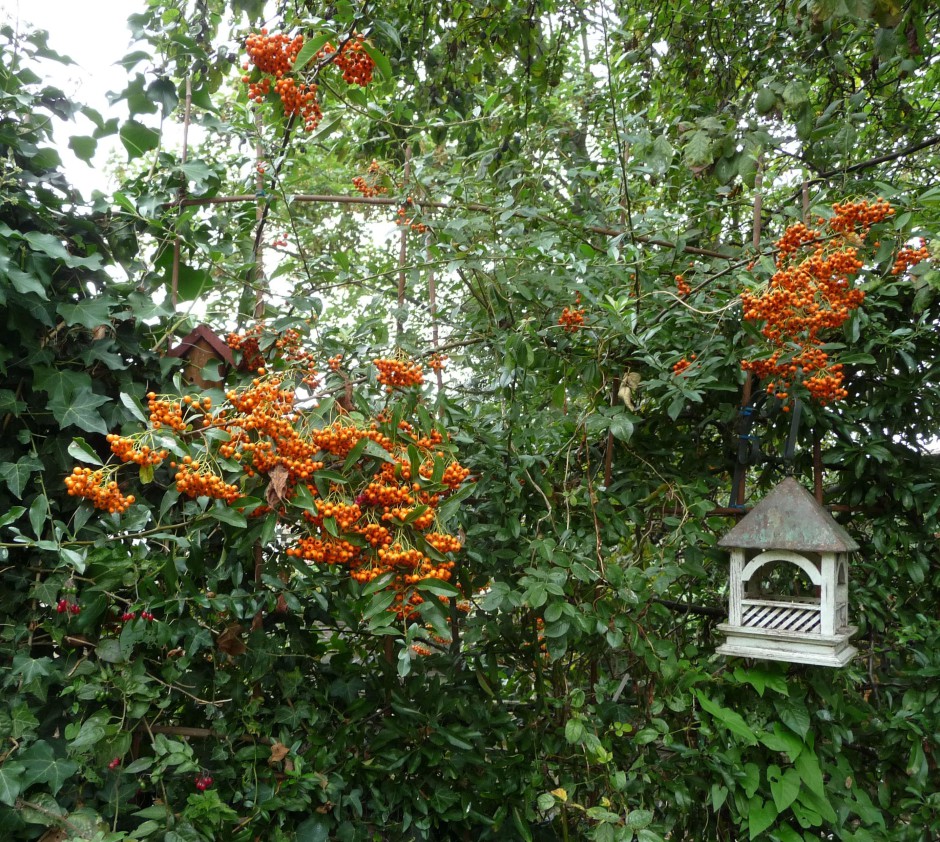PYRACANTHA (Firethorn)
Europe to SW Asia, the Himalayas, China & Taiwan
There are seven species of Pyracantha, large evergreen shrubs native to Europe, the Himalayas, China & Taiwan. Fossil fruits of Pyracantha acuticarpa dating from the Middle Miocene Era (between 17 million & 15 million years ago) have been found near Silkeborg in the Fasterholt area of central Jutland, Denmark.
Known as Firethorn, the plant has small dark green leaves & formidable thorns. It may grow from 6 to 13 ft (2-4 metres) or more, & can withstand great extremes in temperature.
In spring Pyracantha produces CREAM-coloured flowers. These are visited by pollinators; berries follow which remain green through summer & change to RED, YELLOW or ORANGE in autumn, depending on the variety. They may last into winter for hungry birds.
In Greek, ‘pyr’ means fire, & ‘akanthos’ means thorn. Waves of flame-coloured berries guarded by prickly stems make these shrubs quite recognisably fiery and thorny. The Pyracantha genus was defined by 19th Century botanist Max Joseph Roemer.
Edible and Medicinal
‘These berries are eaten globally as a traditional remedy for treating different stomach abnormalities, & as a cooking ingredient for folk diets.’ Antioxidant, anti-inflammatory, antimicrobial, larvicidal and cytotoxic properties
Biological activities and health-promoting effects of Pyracantha genus / a key approach to the phytochemical’s potential / Cellular and molecular biology – Mozilla Firefox
Red berries of Pyracantha fortuneana are known as red fruit or ‘pocket apple in China, as their taste is similar to apple. They are rich in vitamin C, proteins, amino acids & trace elements. Drinks are made from the berries. Their active substances prevent cavities & are often added to toothpaste. The leaves can be made into tea.
The whole of the Pyracantha plant can be used as medicine. The fruit can stop bleeding, promote blood circulation, & be used to treat conditions such as dyspepsia, dysentery, & enteritis. The plant’s roots are used to treat hepatitis, bruises, muscle pain & other conditions. The leaves, taken internally, are an aid to detoxification; applied externally they treat soreness & swelling.
Edible and Medicinal Functions of Pyracantha, The Plant Aide, Mozilla Firefox.
Pyracantha Wine
‘ One of the uses of Pyracantha is to prepare a base wine. Pyracantha berries are picked when fully ripened. The ingredients are 1 kg Pyracantha berries, 1 cup golden raisins, 1 kg sugar, 2 lemons, 1 large orange, 5 g pectic enzyme, 10 g yeast nutrient, 2 L water, and wine yeast. To prepare Pyracantha wine, the berries are sorted, destemmed, and washed…’
Part of a recipe from Pyracantha – an overview (ScienceDirect). Specific Features of Table Wine Technology, V.K.Joshi & P.S.Panesar in Science and Technology of Fruit Wine Production, 2017.
Wildlife, Bees Favourite
” They are also good shrubs for a wildlife garden, providing dense cover for roosting & nesting birds, summer flowers for bees & an abundance of berries as a food source.
In the UK & Ireland Pyracantha and the related genus Cotoneaster are valuable sources of nectar when often the bees have little other forage during the June Gap.”
https://en.wikipedia.org/wiki/Pyracantha
Gardening chat rooms have looked at which berry colour is a favourite with the birds, & red berries seem to always be eaten first… Here we can vouch for the orange berries. Eaten to the last berry.
Yet when a few nearby ‘street trees’ drop their berries, they lie where they have fallen on the pavement, walked over by passersby. Wildlife seems to know which fruit is good for them & which is not.
Gardening with Pyracantha
Remember its thorns when working with Pyracantha, & always wear gloves. Ordinary garden compost will do as long as it does not get waterlogged. The plant will produce its best crop of berries if it is sited in full sun. The best time for cutting back is at the end of winter.
Pyracantha can be trained & trimmed into a prickly, intruder-proof evergreen hedge which will be covered with blossom in spring & berries in the fall. It can be espaliered (trained against a wall or fence), & it can be fashioned into topiary. Position is important. If being planted for security, such as beneath windows, Pyracantha’s thorniness is an extra bonus. Otherwise those thorns will be poking gardeners, family, visitors…
“Their dense thorny structure makes them particularly valued in situations where an impenetrable barrier is required. … aesthetic characteristics of Pyracanthas, in conjunction with their home security qualities, makes them an alternative to artificial fences & walls.’
https://www.wikihow.com/Plant-Pyracantha how to plant pyracantha (with pictures) wikihow
Topiary
The world’s oldest & most famous topiary garden is Levens Hall in Cumbria, parts of which date to 1694. There the Elizabethan House looks out across 10 acres of topiary gardens created by Monsieur Guillaume Beaumont, former head gardener to James 11 & creator of The Wilderness Garden at Hampton Court Palace.
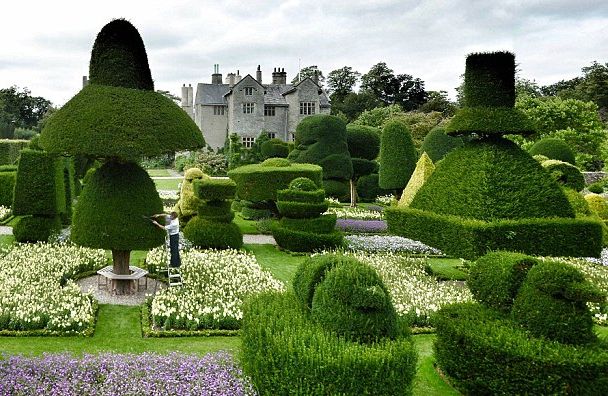
Head gardener Chris Crowder clipping The Great Umbrella in Levens Hall Topiary Garden. Story and Pictures by North News
Topiary was fashionable from the 1660s; in due course it could be found all over the country. Most topiary gardens of the time, however, were replaced with the rolling hills & serpentine ponds of Capability Brown (master gardener to King George III). We must be grateful that the Levens Hall Topiary Gardens survive at all.
Levens Hall & Gardens will open from 2 April to 6 Oct 2023. On World Topiary Day, Sunday May 14 2023, topiary tours with the head gardener will take place at 11am, 1pm & 3pm. https://www.levenshall.co.uk/gardens 
.
Topiary in North London
To see the topiary at Levens Hall, a Londoner has got to travel some distance to Cumbria… Topiary can be seen here in the south of England, at great gardens such as Hampton Court Palace or Great Dixter. But it is rare to find it in the streets of central London. So it is that the work of architect & topiarist Tim Bushe is much appreciated locally.
” For me, it is important that the hedges I cut are in urban locations and front gardens, available for everyone to see. Hedges are more effective at absorbing pollution than trees, and I like to raise awareness of endangered animals too. I’m tempted to do a little herd of rhinos next, to remind people what glorious creatures they are. “
‘This Londoner turns city hedges into amazing animal sculptures’, Julia Rampen for Time Out Magazine, 14 May 2018
Tim Bushe and His Topiary Elephants / Out of My Shed / https://outofmyshed.co.uk/tag/tim-bushe-and-his-topiary-elephants/
Proceeds from Tim’s topiary go to Hft, the charity that supports his sister who has Downs Syndrome. www.justgiving.com/fundraising/tim-bushe
Pyracantha Topiary – A Work in Progress
Across the road from Tim Bushe‘s elephants. a Pyracantha hedge is being clipped into topiary. Waves of orange berries running the length of the hedge make it a blaze of colour every autumn.
The lush heavily-berried bit of hedge by the gate could be a fox’s tail. If it is, when the hedge has regrown into its new topiary shape, it will be a leafy green fox for part of each year. In spring it will become a flowery cream fox, evolving into a spectacular orange fox from autumn on. Fantastic.
Hedging – Box Blight
Historically, hedging species in Elizabethan knot gardens were the slow-growing Box & Yew. Privet is most often seen locally, as it grows more quickly than Box or Yew.
In 1998 a fungus known as Box Blight (Cylindocladium buxicola) appeared in the UK, & it has since devastated much of the country’s Box hedging. The fungus is most active in rainy seasons, & the UK has plenty of those. Young shoots are infected; green hedges turn brown & crispy, with bare patches & die-back.
In Cumbria, Levens Hall had to deal with Box Blight in 2011. Head Gardener Chris Crowder said larger specimens had not been affected, but the low edging for the knot gardens was being replaced with species other than Box.
In Herefordshire, Gardeners World’s Monty Don had to deal with the ruination of his fabulous Box hedging at Longmeadow. After trying & failing to save them from the fungus, he had to cut them down.
In London, on a smaller scale, a number of Highbury residents found their standard topiary trees & Box balls had gone from verdant green to sickly, dusty brown.
The RHS recommends that gardeners isolate & quarantine new plants for 4 weeks; clean all tools before using them on other plants; & leave more space between plants.
Our local topiarist, Tim Bushe, has created his living sculptures mostly from mature Privet hedges. Privet grows quickly, needing a trim 3 times a year. It is not susceptible to Box Blight.
When choosing an alternative hedging species to Box, why not consider Pyracantha. In the right place, its wildlife friendly credentials & reputation as a prickly security guard could make it worth choosing. (See also our What You Can Do for Wildlife page – ‘Grow a Mixed Native Hedge’. Pyracantha may not be a native, but it is wildlife friendly.
Pyracantha in our Highbury Garden
Years ago RF planted our first Firethorn near the path from the house into the garden, where it became a formidable shrub, a good two metres tall. After it had grown into the path, rasping everyone with its thorns, it was carefully dug up & moved to the southeastern corner. There any watering it received was appropriated by mature trees and shrubs, & we lost it.
RF got a second Pyracantha, possibly from the Columbia Road Sunday market. Judging by images on the net, it could be ‘orange glow’. It now lives on the opposite side of the garden, facing south.
RHS advice: https://www.rhs.org.uk/advice/profile?pid=431
